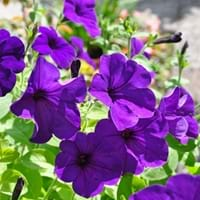Life Span
Perennial
Annual
Type
Bulb or Corm or Tuber
Flowering Plants, Shrubs
Origin
South America
Hybrid origin
Types
Pamianthe cardenasii , Pamianthe parviflora , Pamianthe peruviana
19
Habitat
All sorts of environments
Terrestrial
USDA Hardiness Zone
8-10
9-10
AHS Heat Zone
10-8
12 - 3
Sunset Zone
21,22
A1, A2, A3, H1, H2, 1a, 1b, 2a, 2b, 3a, 3b, 4, 5, 6, 7, 8, 9, 10, 11, 12, 13, 14, 15, 16, 17, 18, 19, 20, 21, 22, 23, 24
Habit
Clump-Forming
Prostrate/Trailing
Flower Color
White
White, Blue, Purple, Pink, Light Pink, Hot Pink, Magenta, Lavender
Flower Color Modifier
Bicolor
Bicolor
Fruit Color
Green
Not Available
Leaf Color in Spring
Dark Green
Green
Leaf Color in Summer
Light Green
Green
Leaf Color in Fall
Several shades of Green
Green
Leaf Color in Winter
Light Green
Light Green
Leaf Shape
Strap shaped
Ovate
Plant Season
Spring, Summer, Fall
Spring, Summer, Fall
Sunlight
Partial Sun, Partial shade
Full Sun
Growth Rate
Fast
Very Fast
Type of Soil
Loam, Sand
Loam, Sand
The pH of Soil
Acidic, Neutral, Alkaline
Acidic, Neutral
Soil Drainage
Average
Well drained
Bloom Time
Spring, Late Spring, Early Summer, Summer, Late Summer
Indeterminate
Tolerances
Drought
Drought
Where to Plant?
Ground, Pot
Container, Ground, Pot
How to Plant?
Offsets
Seedlings, Transplanting
Plant Maintenance
Medium
Medium
Watering Requirements
Keep the ground moist but not water-logged
Keep the ground moist but not water-logged, Requires regular watering, Requires watering in the growing season
In Summer
Lots of watering
Lots of watering
In Spring
Moderate
Moderate
In Winter
Average Water
Average Water
Soil pH
Acidic, Neutral, Alkaline
Neutral
Soil Type
Loam, Sand
Loamy, Sandy
Soil Drainage Capacity
Average
Well drained
Sun Exposure
Partial Sun, Partial shade
Full Sun, Partial shade
Pruning
Pinch or prune as they grow to promote branching and bushiness, Remove damaged leaves, Remove dead branches, Remove dead leaves, Requires little pruning
Cut or pinch the stems, Do not prune during shooting season, Remove dead or diseased plant parts, Remove deadheads
Fertilizers
All-Purpose Liquid Fertilizer, High phosphorus
All-Purpose Liquid Fertilizer
Pests and Diseases
Leaf spot, Mosaic viruses
Red blotch
Plant Tolerance
Drought
Drought
Flower Petal Number
Single
Single
Foliage Texture
Coarse
Medium
Foliage Sheen
Glossy
Matte
Attracts
Bees, Birds, Bumblebees, Butterflies, Hummingbirds, pollinators
Hummingbirds, Butterflies
Allergy
Unknown
Not Available
Aesthetic Uses
Beautification, Bouquets, Ornamental use, Showy Purposes
Beautification, Bouquets, Showy Purposes
Beauty Benefits
No Beauty Benefits
Not Available
Environmental Uses
Air purification
Air purification
Medicinal Uses
No Medicinal Use
Not Available
Part of Plant Used
Not Available
Flowers
Other Uses
Beneficial species for attracting pollinators, Decoration Purposes
Showy Purposes
Used As Indoor Plant
No
Yes
Used As Outdoor Plant
Yes
Yes
Garden Design
Bog Garden, Container, Feature Plant, Foundation, Mixed Border, Water Gardens
Hanging Basket
Botanical Name
HYMENOCALLIS longipetala
PETUNIA 'PAS3187'
Common Name
Peruvian Daffodil, Spiderlily
Purple Wave Petunia, Spreading Petunia, Wave Purple Petunia
In Hindi
peruvian daffodil
Purple wave petunia
In German
peruvian daffodil
Lila Welle Petunie
In French
peruvian daffodil
Pétunia pourpre Vague
In Spanish
Pamianthe
Petunia púrpura Wave
In Greek
peruvian daffodil
Purple Wave πετούνια
In Portuguese
peruvian daffodil
Onda roxa do petúnia
In Polish
peruvian daffodil
Purpurowy fali petunii
In Latin
peruvian daffodil
Purpura unda Petunia
Phylum
Magnoliophyta
Magnoliophyta
Class
Liliopsida
Magnoliopsida
Order
Asparagales
Solanales
Family
Amaryllidaceae
Solanaceae
Clade
Angiosperms, Monocots
Angiosperms, Asterids, Eudicots
Tribe
Clinantheae
Not Available
Subfamily
Amaryllidoideae
Petunioideae
Number of Species
Not Available
Importance of Peruvian Daffodil and Purple Wave Petunia
Want to have the most appropriate plant for your garden? You might want to know the importance of Peruvian Daffodil and Purple Wave Petunia. Basically, these two plants vary in many aspects. Compare Peruvian Daffodil and Purple Wave Petunia as they differ in many characteristics such as their life, care, benefits, facts, etc. Every gardener must at least have the slightest clue about the plants he wants to plant in his garden. Compare their benefits, which differ in many ways like facts and uses. The medicinal use of Peruvian Daffodil is No Medicinal Use whereas of Purple Wave Petunia is Not Available. Peruvian Daffodil has beauty benefits as follows: No Beauty Benefits while Purple Wave Petunia has beauty benefits as follows: No Beauty Benefits.
Compare Facts of Peruvian Daffodil vs Purple Wave Petunia
How to choose the best garden plant for your garden depending upon its facts? Here garden plant comparison will help you to solve this query. Compare the facts of Peruvian Daffodil vs Purple Wave Petunia and know which one to choose. As garden plants have benefits and other uses, allergy is also a major drawback of plants for some people. Allergic reactions of Peruvian Daffodil are Unknown whereas of Purple Wave Petunia have Not Available respectively. Having a fruit bearing plant in your garden can be a plus point of your garden. Peruvian Daffodil has no showy fruits and Purple Wave Petunia has no showy fruits. Also Peruvian Daffodil is not flowering and Purple Wave Petunia is not flowering . You can compare Peruvian Daffodil and Purple Wave Petunia facts and facts of other plants too.





